Archive for August 2013
Tylenol users get a new warning
- New caps will say: "Contains acetaminophen. Always read the label"
- Company hopes to reduce number of accidental acetaminophen overdoses
- FDA sets daily limit for adults at 4,000 milligrams of acetaminophen
(CNN) -- Bottles of Extra Strength Tylenol will soon have a new warning on their caps: "Contains acetaminophen. Always read the label."
The bright red lettering is an effort by Tylenol's parent company, Johnson & Johnson, to reduce the number of accidental acetaminophen overdoses that occur each year.
"Acetaminophen overdose is one of the most common poisonings worldwide," according to the National Institutes of Health.
Taking too much of this pain reliever can cause severe liver damage. The Food and Drug Administration sets the maximum limit for adults at 4,000 milligrams per day. One gel tablet of Extra Strength Tylenol contains 500 mg.
People should keep their doctor and pharmacist informed about all the medications they are taking to ensure that they are not consuming more than the daily limit, according to the FDA. They should also avoid taking acetaminophen with alcohol.
"With more than 600 (over the counter) and prescription medications containing acetaminophen on the market, this is an important step because it will help remind consumers to always read the label," Johnson & Johnson said in a statement about the new caps, which will arrive in October.
Gupta: Let's end the prescription drug death epidemic
CNN's Jacque Wilson and John Bonifield contributed to this story.
Girl, 6, dies in crash; brother, 8, driving
- A 6-year-old girl is dead after her 8-year-old brother took her for joyride
- The car crashed into a pole in Phoenix Wednesday night
- The children's mom believed they had been kidnapped
- "It's a tragic story, all the way round," Phoenix police say
(CNN) -- A 6-year-old girl has died after her 8-year-old brother took her on a joyride in their mother's car and crashed Wednesday night in South Phoenix, police said.
The children's mother believed they had been kidnapped when she discovered they were missing, said Sgt. Steve Martos of the Phoenix Police Department.
"It's a tragic story, all the way round," said Martos, who did not give the children's names.
The mother gave the children a bath and put them to bed around 9:30 p.m., he said.
The children's grandmother, who lives nearby, was driving home when saw her daughter's front door open.
She went in, woke up the woman, and they discovered both the children were missing, Martos said.
As they came out to check with neighbors, the children's mother discovered that her car -- a 2010 Hyundai Elantra which had been parked outside -- was also gone, Martos said.
The frantic mother called 911 around 10:25 p.m., saying she believed someone had kidnapped her children.
Police said they started to get numerous 911 calls starting around 10:15 p.m. One caller said the car had struck a fence. Another who followed the vehicle reported that children were inside.
At around 10:30 p.m., when police tried to pull the vehicle over, it veered to the right and hit a pole, Martos said.
"This was one of those situations when the officers believed they were trying to rescue kids from a possible kidnapper," Martos said.
"When they ran up to the vehicle, they found an 8-year-old in the driver's seat, and a 6-year-old in the passenger seat, severely injured."
Responding officers started life-saving measures until the fire department arrived, Martos said.
Both the children were dressed in their pajamas. The 6-year-old was not wearing a seat belt. The air bag did not deploy.
The mother, who lives within a block of the where the accident occurred walked to the scene and discovered that her children were in the car.
The 6-year-old died around 4 a.m. Thursday in a local hospital. The 8-year-old boy was treated for minor injuries.
Martos said at this point they do not know what prompted the 8-year-old to take his mom's car. They have not spoken to the boy, but no criminal complaints are expected to be filed, he said.
CNN's Meredith Edwards contributed to this story.
N.J. texting ruling not what you think
- Marc Randazza: Buzz on New Jersey texting ruling leaves wrong impression
- Judge did not rule that a woman texting a driver was legally liable for the crash, he says
- Randazza: As in the McDonald's scalding case, misinformation feeds ignorance
- You may be liable only if you know the person you're texting is driving, he says
Editor's note: Marc J. Randazza is a Las Vegas-based First Amendment attorney. He is licensed to practice in Arizona, California, Florida, Massachusetts and Nevada. He is the editor of the law blog, The Legal Satyricon.
(CNN) -- The headlines and blogs are all abuzz with the latest news: If a driver who's texting gets in an accident and you sent the text, you can be arrested! Terrible, right?
Actually, it's not true, despite what you may have been told by people who have seen two episodes of some lawyer show and think they are qualified to be legal analysts. Such ignorance about the law feeds misinformation that grows on itself, doubles back and makes us all dumber.
For people like me, lawyers, that is a wonderful thing. Why? Because people who have no idea what they are talking about wind up making simple legal situations complicated, ramping up the billable hours for all of us.

Remember the McDonald's hot-coffee lawsuit? That case, maligned from coast to coast, stands in the public mind as the one that says, "If you are stupid enough to spill hot coffee on yourself, you deserve hundreds of millions of dollars."
Anyone who knows anything about the law will tell you that the real ruling came down for the plaintiff because McDonald's had been warned time and again that it was going to hurt somebody if it didn't do something about the scalding temperature at which it served its coffee. But, in the name of more profits, it ignored the warnings. Even thereafter, McDonalds had the opportunity to pay the 81-year-old woman's medical bills -- she was seriously injured, with third-degree burns -- but it acted arrogantly.
McDonald's did something wrong. When it was called to task for it, the punishment had to fit the defendant. Fining McDonalds $1,000 just wasn't going to do it. Hitting McDonalds with a huge multimillion-dollar settlement? That did it. (The injured woman's $2.86 million jury award was later reduced, however, by a judge to $640,000.)
So what has that to do with the New Jersey texting case?
 Viewfinder - Texting While Driving
Viewfinder - Texting While Driving  Famed director's new PSA on texting
Famed director's new PSA on texting  Don't walk and text
Don't walk and text The New Jersey texting case will likely lead to more boneheads who get their legal acumen from "My Cousin Vinny" expounding on its meaning. This chorus shrieks that the New Jersey decision makes you liable for sending a text. But the court actually held that the person doing the texting was not liable in this instance.
The court held that theoretically, someone could be held liable for sending a text to a driver. But the ruling was very clear, and very, very limited:
"We hold that the sender of a text message could potentially be liable if an accident is caused by texting but only if the sender knew or had special reason to know that the recipient would view the text while driving and thus be distracted."
In other words, yes, you can be held responsible if you cause an accident by sending a text message. But only if you knew that the recipient would look at the text message while driving. If you had any reason to have any doubt in your mind, then you will likely not be held liable.
So if you send a text message to someone, you need not then call your lawyer or your insurance company. But if you send someone a text message and they respond back "driving, leave me alone" and then you keep sending text messages, perhaps you might be found liable.
The only thing that is certain is that this case, which makes plenty of sense, will serve to continue to allow the common law to grow, while those who would like to bring ignorance to our knowledge of the legal system will continue to succeed.
Follow us on Twitter @CNNOpinion.
Join us on Facebook/CNNOpinion.
The opinions expressed in this commentary are solely those of Marc J. Randazza.
Why cyberattacks from Syria matter

- On Tuesday afternoon, the New York Times website went down for several hours
- James Lewis: Syrian Electronic Army launched the attack to protest the West
- He says the group of "patriotic hackers" dislike U.S. media portrayal of al-Assad regime
- Lewis: Some audiences in the Mideast enjoy seeing Western institutions humbled
Editor's note: James Lewis is director and senior fellow of Technology and Public Policy Program at the Center for Strategic and International Studies.
(CNN) -- On Tuesday afternoon, the New York Times website experienced wide outage for several hours. Who has the nerve and ability to take down one of the most iconic newspapers in the world?
The Syrian Electronic Army, which is loyal to Syrian President Bashar al-Assad, takes responsibility for the hack. This is not the first time the Syrian Electronic Army has attacked news organizations. The Washington Post, AP and others have been targeted in recent months as well.
If the New York Times saw Syrian activists spray-painting slogans on its building, it could summon the minions of the law to detain them. But if you live far away in a place where American law does not apply, you are safe. It does not take much skill to intrude in cyberspace, and you can find free tools on the Internet that will let you stage a protest or an attack.
When you log on to the Internet, you can send packets of digital data around the world in seconds. The speed of global connectivity gives the illusion that there are no borders. But this is not true. There are borders in cyberspace, they are just badly defended.
The combination of high speeds, global reach and weak defenses means that someone sitting in Damascus or Tehran can take action in New York or Australia as easily as they could against the building across the street -- perhaps even easier as they won't have to leave their chair.
The Syrian Electronic Army's attacks are a form of protest against Western media's portrayal of the Assad regime. Most experts think the Syrian Electronic Army is not the Syrian government, but "patriotic hackers" who support it. This makes them harder to control and harder to find. The Syrian Electronic Army takes public diplomacy to a new level, letting individuals make their voices known on issues as easily as a government.
What we have seen from the Syrian Electronic Army is political action and sometimes political theater. Hacker groups like Anonymous, WikiLeaks or the Syrian Electronic Army have a symbiotic relationship with media that helps turn minor exploits into front-page news. The Syrian Electronic Army likes to go after the media because this is one way to make sure your message is heard. The Syrian Electronic Army's message to the Western media is one of scorn, ridicule and belittlement.
This week's attack showed more skill than earlier episodes. It resembled a cyber attack made by Iran against dissidents in 2011. Perhaps the Iranians are helping the SEA in cyberspace, but it's more likely that they provided inspiration.
The Syrian Electronic Army broke into the Australian company that hosts The Times' website (called a registrar) and changed its Internet addresses. This redirection was invisible to users who tried to visit NYTimes.com -- they either couldn't connect or were sent to another website controlled by the Syrians. The hackers got inside the target network and made some fundamental changes to how it worked. Some security experts have pointed out that The Times made its own networks vulnerable because of a "misstep" and as a result its website was easier to hack.
So far, the Syrian Electronic Army's actions have been embarrassing rather than damaging. The attackers probably don't know how to carry out a more destructive attack. But with time they could easily learn.
The Syrian Electronic Army's hacking won't change the outcome of the conflict in Syria (whatever that will be), but we don't want to discount the political effect of their actions. Some audiences in the Middle East likely enjoy seeing Western institutions humbled, and the Syrian Electronic Army is helping to dispel a sense of powerlessness against the Western behemoth. It boosts morale.
We also don't want to discount the risks. If the Syrian Electronic Army can slip by feeble defenses to make fun of the media, someone else might be able to get in and cause more serious disruption. There are a lot of reasons why the Syrian Electronic Army might choose not to launch this kind of crippling cyber attack, but the strength of our defense isn't one of them.
There are things that companies can do to protect themselves. Australia's Signals Directorate, the equivalent of NSA, has a list of mitigation strategies that would have block most of the Syrian Electronic Army does, but they aren't well known in the U.S.
The global Internet brings tremendous, benefit but the threats are growing faster than our defenses. It's a vulnerable place with few rules. Until this is changed, hacks on The New York Times and others will be the norm, not the exception.
Follow us on Twitter @CNNOpinion.
Join us on Facebook/CNNOpinion.
The opinions expressed in this commentary are solely those of James Lewis.
460-mile megacanyon discovered
- A 460-mile canyon up to half a mile deep lies beneath Greenland's ice
- The discovery was reported in a scientific journal Thursday
- "It looks like it was a pretty extensive river system millions of years ago," scientist says
(CNN) -- British and American scientists watching Greenland's massive ice sheet have found what appears to be a 460-mile "megacanyon" far beneath the frozen surface of the world's largest island.
Airborne radar images taken by the U.S. space agency NASA and compiled by scientists at the University of Bristol revealed the canyon's existence, Bristol glaciologist Jonathan Bamber said Thursday. It's buried under the layer of ice that blankets Greenland, a covering up to 3 kilometers (1.9 miles) thick.
The gouge is more than half again as long as Arizona's 277-mile Grand Canyon, but not as deep -- ranging from 650 feet to about 2,600 feet (200 to 800 meters), Bamber said. It runs from the middle of Greenland to its northern shore, on the Arctic Ocean, and it's likely to have been covered over by ice for 4 million years.
"It's a continuous canyon. It's pretty deep. It very much looks like it predates the ice sheets," Bamber said. "We think it's indicative of a river system that was here before the ice sheet was there, and which perhaps was modified by the ice sheet cover some, but not much."
 As scientists study receding ice in Greenland, many residents simply do what they've always done: adapt.
As scientists study receding ice in Greenland, many residents simply do what they've always done: adapt.  "We're used to change,'' said Greenlander Pilu Neilsen. "We learn to adapt to whatever comes. If all the glaciers melt, we'll just get more land." Nielsen and his brother Kunuk, piloting the boat, try to capture a goat that became stuck at the bottom of a cliff near the water on the family's farm on July 30 in Qaqortoq.
"We're used to change,'' said Greenlander Pilu Neilsen. "We learn to adapt to whatever comes. If all the glaciers melt, we'll just get more land." Nielsen and his brother Kunuk, piloting the boat, try to capture a goat that became stuck at the bottom of a cliff near the water on the family's farm on July 30 in Qaqortoq.  Arnaq Egede works among the plants in her family's potato farm on July 31 in Qaqortoq. The farm, the largest in Greenland, has seen an extended crop-growing season because of climate change.
Arnaq Egede works among the plants in her family's potato farm on July 31 in Qaqortoq. The farm, the largest in Greenland, has seen an extended crop-growing season because of climate change.  A boat navigates among calved icebergs from the nearby Twin Glacier on July 31 near Qaqortoq. Boats are a crucial mode of transportation in a country that has few roads.
A boat navigates among calved icebergs from the nearby Twin Glacier on July 31 near Qaqortoq. Boats are a crucial mode of transportation in a country that has few roads.  Calved icebergs from the Twin Glacier float July 30 near Qaqortoq.
Calved icebergs from the Twin Glacier float July 30 near Qaqortoq. 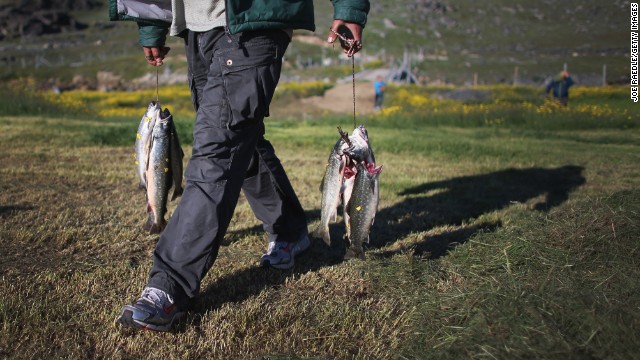 Trout caught in a stream July 30 in Qaqortoq. Even though this summer has not been as warm as last year, the warmer weather has extended the growing season.
Trout caught in a stream July 30 in Qaqortoq. Even though this summer has not been as warm as last year, the warmer weather has extended the growing season.  Greenland adapts to climate change
Greenland adapts to climate change The discovery is a byproduct of the intense scientific focus on Greenland amid concerns about rising global temperatures. The radar images were shot by NASA's Operation IceBridge, which flies aircraft over the island because the ice sheet is too thick for satellite-based radar to penetrate, said Michael Studinger, the project's lead scientist.
Bamber and colleagues from Bristol, the University of Calgary in Canada and Urbino University in Italy published their findings Thursday in the journal Science. They were trying to compile an updated set of ice-sheet records when they noticed "this long linear feature that seemed to be pretty continuous," Bamber said.
"It looks like it was a pretty extensive river system millions of years ago," he said.
The find isn't a "first-order concern" for scientists studying climate change but will help researchers understand how the ice ebbs and flows across the face of Greenland and other polar environments, Bamber said.
The main reason Greenland is under study is to record the height of the ice above it, not to map the land beneath, Studinger said. The existence of the canyon is "basically a tiny piece in the big puzzle of what's going on in Greenland," but still an exciting find, he said.
"We live in the 21st century, and we are still discovering 750-kilometer features under the Greenland ice sheet that we didn't know about," he said.
As climate warms, Arctic spawns massive ice islands
Is 'class' the new 'race'?
 August 28, 1963, was one of the most important days for the civil rights movement. Over 200,000 people gathered on the National Mall in Washington to hear Martin Luther King Jr. deliver his famous "I Have a Dream" speech from the steps of the Lincoln Memorial. Magnum photographer Leonard Freed (1929-2006) was there documenting that historic day.
August 28, 1963, was one of the most important days for the civil rights movement. Over 200,000 people gathered on the National Mall in Washington to hear Martin Luther King Jr. deliver his famous "I Have a Dream" speech from the steps of the Lincoln Memorial. Magnum photographer Leonard Freed (1929-2006) was there documenting that historic day. 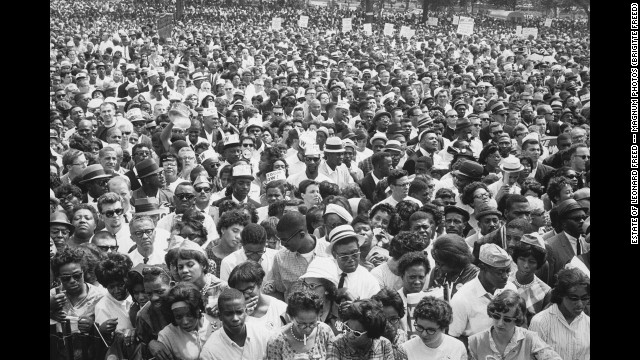 The crowd gathers at the National Mall.
The crowd gathers at the National Mall.  People sing together during the march.
People sing together during the march. 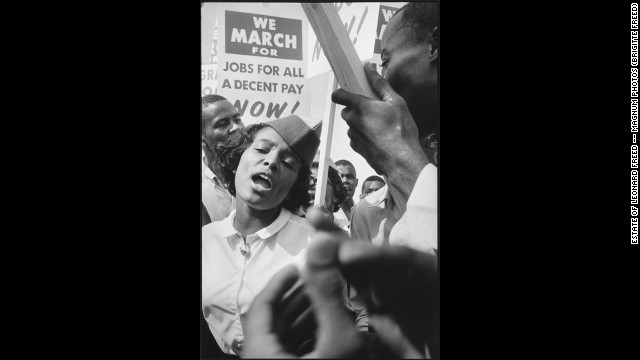 Though the name March on Washington"is well known, the full title of the gathering the March on Washington for Jobs and Freedom.
Though the name March on Washington"is well known, the full title of the gathering the March on Washington for Jobs and Freedom.  People sing together during the rally.
People sing together during the rally. 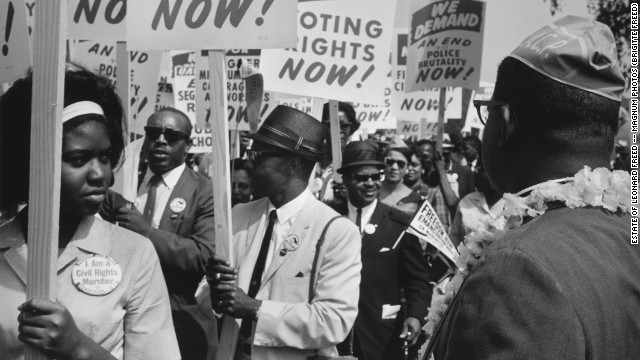 Ten leaders of the civil rights movement met with President John F. Kennedy, Vice President Lyndon B. Johnson, Labor Secretary W. Willard Wirtz and Burke Marshall, head of the Justice Department's Civil Rights Division, in the Cabinet room of the White House during the demonstration.
Ten leaders of the civil rights movement met with President John F. Kennedy, Vice President Lyndon B. Johnson, Labor Secretary W. Willard Wirtz and Burke Marshall, head of the Justice Department's Civil Rights Division, in the Cabinet room of the White House during the demonstration.  People watch and wait for speakers.
People watch and wait for speakers. 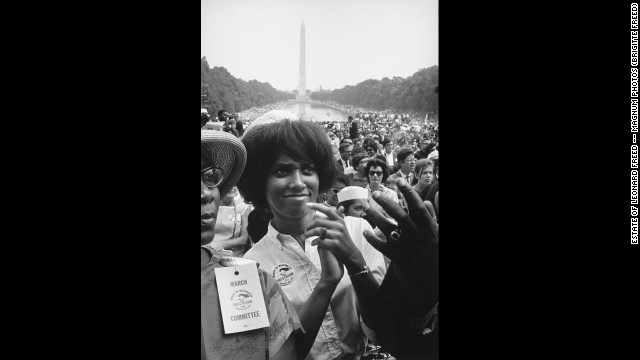 Though the most iconic shot from the March on Washington may be of King waving to the crowd, Freed moved throughout the crowd finding the faces that weren't seen in the papers.
Though the most iconic shot from the March on Washington may be of King waving to the crowd, Freed moved throughout the crowd finding the faces that weren't seen in the papers.  The marchers were entertained by big names such as Ossie Davis, Joan Baez, Bobby Darin, Odetta, Bob Dylan, Peter, Paul and Mary, and Jackie Robinson.
The marchers were entertained by big names such as Ossie Davis, Joan Baez, Bobby Darin, Odetta, Bob Dylan, Peter, Paul and Mary, and Jackie Robinson. 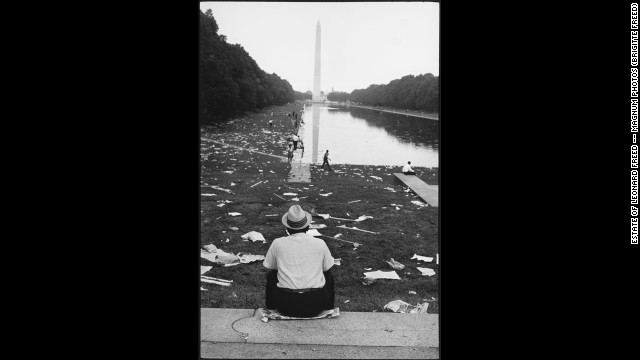 This year marks the 50th anniversary of the historic march.
This year marks the 50th anniversary of the historic march. - Fast-food workers scheduled protests across the country this week
- John Sutter: Class seems to be the social justice issue of our time
- It's been 50 years since the "March on Washington for Jobs and Freedom"
- Economic justice remains a distant dream for many, Sutter says
John D. Sutter is a columnist for CNN Opinion and head of CNN's Change the List project. Follow him on Twitter, Facebook or Google+. E-mail him at ctl@cnn.com.
(CNN) -- Let's play a little game.
Which of the following signs did protestors hold at the March on Washington, 50 years ago this week, and which were held up this year by fast-food workers:
1. "WE MARCH FOR HIGHER MINIMUM WAGESCOVERAGE FOR ALL WORKERS NOW!"
2. "WE ARE WORTH MORE"
3. "I AM A MAN"
4. "WE MARCH FOR JOBS FOR ALL A DECENT PAY NOW!"
The exclamation points, which apparently were more popular in the 1960s (despite what Twitter would have you believe!!!), are your best clue.

Signs one and four are from 1963. Two and three are from 2013.
Fifty years later, it's easy to forget that the full name of the 1963 "March on Washington" was actually "The March on Washington for Jobs and Freedom."
Sutter: 99 must-reads on economic inequality
But flip through some pictures from that rally, where Martin Luther King Jr. gave his famous "I Have A Dream" speech and where civil rights leaders, to borrow his words, bent the arc of history towards justice and greater equality, and you'll see protest signs that put the economy as a front-and-center issue, just as it is now.
"CIVIL RIGHTS PLUS FULL EMPLOYMENTEQUALS FREEDOM."
 Fast food workers demand fair pay
Fast food workers demand fair pay President Obama, in commemorating the 50th anniversary of that march this week, smartly picked up on the theme that economic equality is "the great unfinished business" of King's vision for a just and fair America.
"...[A]s we mark this anniversary, we must remind ourselves that the measure of progress for those who marched 50 years ago was not merely how many blacks had joined the ranks of millionaires; it was whether this country would admit all people who were willing to work hard, regardless of race, into the ranks of a middle-class life," Obama said Wednesday. "The test was not and never has been whether the doors of opportunity are cracked a bit wider for a few. It was whether our economic system provides a fair shot for the many, for the black custodian and the white steelworker, the immigrant dishwasher and the Native American veteran."
The subtext of his argument: Class may be the new race.
It's not that all battles for racial equality have been won -- they haven't -- or that we live in a post-racial society. But, in some remarkable and troubling ways, class has become an increasingly significant barrier to equality in modern America. The gap between rich and poor has been growing in the United States since the late 1970s, and our level of income inequality, one proxy measure for that gap, is now on par with many sub-Saharan African countries.
Sutter: Who cares about the economy? ... You!
It's become more difficult for the poor to move up into the middle class and more difficult for the middle to dig in its heels to stop from slipping into poverty.
The American mantra of "work hard and you'll get ahead" is not always enough to sustain people. It's harder now to secure a financial future.
This is the theme that underlies much of what's happening in America today. And it's something that goes back much farther than the recent recession.
The fast-food workers, for example, who scheduled demonstrations across the country on Thursday, are frustrated by the fact that they can't make ends meet on $7.25 per hour. If you doubt whether that's true, please take a look at one fast-food worker's budget. Some workers, as Forbes reports, have to choose between paying for rent or food. "Should I pay my light bill (or) should I pay my gas?" one fast-food worker asks in this CNNMoney video. "I never can pay it all at once."
"Right now the gas is off," she says.
The workers demand a living wage of $15 per hour.
I'm not sure what the fair wage would be. That's the subject for another column...or perhaps a book. But I do know that, as The Atlantic reports, fast-food workers in Australia make $14.50 an hour, about twice the U.S. minimum wage.
And burgers haven't become too expensive Down Under.
Some context is helpful for understanding that movement as well.
The U.S. minimum wage is actually lower than it was in the late 1960s. Five years after King's speech in front of the Lincoln Memorial, the federal minimum wage, when converted into 2013 dollars, was $10.70, compared to $7.25 now. (The nominal minimum wage, according to the Congressional Research Service, was only $1.60 per hour in 1968. The $10.70 amount is adjusted for inflation).
Sutter: White House should pay its interns
Education is another example. There's evidence poverty is a better indicator of educational achievement than race.
"According to a 2011 research study by Stanford sociologist Sean Reardon, the test-score gap between the children of the poor (in the 10th percentile of income) and the children of the wealthy (in the 90th percentile) has expanded by as much as 40% and is now more than 50% larger than the black-white achievement gap -- a reversal of the trend 50 years ago," Sarah Garland writes for The Atlantic.
"Underprivileged children now languish at achievement levels that are close to four years behind their wealthy peers."
Four years behind their peers.
Just because of their income.
That challenges the very notion of who we are as Americans.
We see ourselves as a middle-class country -- a place where anyone can work hard and succeed. And many do. We're a country of fighters.
But it's become more difficult for the non-rich to make it.
The country has made great strides toward racial equality since the March on Washington for Jobs and Freedom. But, in the 50 years since King's speech, economic justice seems to have become the more distant dream.
The opinions expressed in this column are solely those of John D. Sutter.
Justice for Down syndrome man

- Ethan Saylor, 26, with Down syndrome, died in a cinema when he refused to leave
- Witnesses say officers put him on floor and handcuffed him, and he died of asphyxiation
- David Perry: Police need to learn to deal with people with disabilities without force
- Perry: We all benefit from disabled rights, we will be old and disabled one day
Editor's note: David M. Perry is an associate professor of history at Dominican University in River Forest, Illinois. You can see more of his writing at his blog: How Did We Get Into This Mess? and follow him on Twitter.
(CNN) -- One day last January, Robert Ethan Saylor, a 26-year-old man with Down syndrome, went to see the movie "Zero Dark Thirty." When it was over, Saylor briefly left the theater, then decided to return and see it again. The manager called security because Saylor didn't pay, and three off-duty deputies, moonlighting at the mall, came in to confront him.
According to Frederick County, Maryland, police statements, he swore at them and refused to leave. The deputies tried to remove him, despite Saylor's caretaker's warnings and pleas for them to wait and let her take care of it. What happened next is a little unclear, but witnesses say the deputies put Saylor on the floor, held him down and handcuffed him. Saylor, called Ethan by his family, suffered a fracture in his throat cartilage. He died of asphyxiation.

The death was ruled a homicide, but a grand jury failed to indict the deputies and they returned to work without charges.
My son has Down syndrome, so I have been following this case closely. But for months, it seemed as if only people in the disability community cared about it.
Petitions for independent investigations sputtered out with just a few hundred votes. Local reporting on the case never made a splash in national media. Meanwhile, the Frederick County sheriff investigated his men's conduct, ruled they had followed procedure correctly, and tried to move on.
Police violence against people with disabilities is not uncommon, but the cases don't seem to get a lot of publicity. Most people see the disabled as, at best, passive victims, objects to care for, perhaps to love, but not people with whom we automatically identify.
This is a mistake. We are all only temporarily able-bodied. Accidents, illness, and age wait for us all. What happened to Ethan Saylor could happen to you.
In July, his death began to get more attention. Heather Mizeur, a member of the Maryland House of Representatives and candidate for governor, seized on Saylor's story and called for new training for law enforcement. Debra Alfarone, an investigative journalist in Washington, began to broadcast and write about the case. A petition asking Gov. Martin O'Malley to investigate went viral in mid-August, garnering 300,000 signatures in just a week. This petition fueled a renewed, suddenly national, media narrative. Ethan Saylor and #JusticeForEthan are now an official cause.
David Perry
What's next? An outside investigation either by the Justice Department or as part of a civil lawsuit might piece together the chain of events from the moment deputies confronted Saylor to his death on the cinema floor. We need an unbiased assessment of responsibility, not just to help the Saylor family understand -- although that's important -- but to help all of us understand what went wrong. When law enforcement officers encounter people with disabilities, things can go wrong very easily.
Dennis Debbaudt trains police on how to respond to people with intellectual disabilities, and argues that such cases require special tactics.
First, he says, law enforcement officers should ensure that they, bystanders and the person with a disability are all out of danger. If the situation is safe, Debbaudt says, officers need to take all the time that's necessary to resolve the problem without force. He tells officers that if the person with a disability isn't "aggressing into the officer's space," then there's generally no good reason to "aggress into theirs."
Saylor's aide was asking the officers to wait, rather than handcuff and arrest him, because he hated to be touched. To wait sounds a lot like common sense. According to both the officers' and witnesses' statements, no one seems to have been in danger, a deputy initiated contact only after Saylor swore at them, and witnesses report that the officers remained calm throughout.
At worst, taking more time would have inconvenienced other moviegoers -- who, in any event, did not see their movie because of the death. I can't say whether the deputies did anything wrong; in fact, they may have followed their typical procedures to the letter. But with just a little more patience, Ethan Saylor could still be alive.
This tragedy raises questions about how people with disabilities fit into society.
The Americans with Disabilities Act suggests that employers must offer reasonable accommodations to workers with disabilities. That standard has entered the broader culture, even as we repeatedly litigate the meaning of "reasonable." Would it have been reasonable to let Saylor watch the movie for free? Would it have been reasonable to try to talk it out for 10 minutes, 30 minutes, an hour, delaying the start of a movie? Would it be reasonable to bar admission to people with disabilities?
Making sure we figure out how to safely include people with disabilities throughout our community matters to everyone. Here's a very different story with an equally tragic ending.
On August 2, John Wrana, a 95-year-old World War II veteran in Park Forest, Illinois, was scared. He didn't want to go to the hospital for surgery, because he didn't want to end up on life support. The staff at his assisted living community decided to involuntarily commit him and called the police. He threatened the staff with a shoehorn and a cane. The police came. They shot him with a Taser and and fired beanbag rounds at him. He died.
The Park Forest police say, "Attempts were made verbally to have the resident comply with demands to drop the articles, to no avail." The police claim he had a kitchen knife, but the family disputes this, saying there was no knife in the old man's room before the incident.
Unlike Robert Ethan Saylor, John Wrana was not born with a disability. He made it through WWII with his body intact. But he was only temporarily able-bodied, then age caught up with him. Once in the world of disability, confused and stripped of his power to govern his body, he encountered the police and was killed.
Disability rights are universal human rights, not abstract principles. But if it takes a personal reason to care about rights for the disabled, remember this: You might need them someday.
Follow us on Twitter @CNNOpinion.
Join us on Facebook/CNNOpinion.
The opinions expressed in this commentary are solely those of David Perry.
Obama is mulling the least bad option
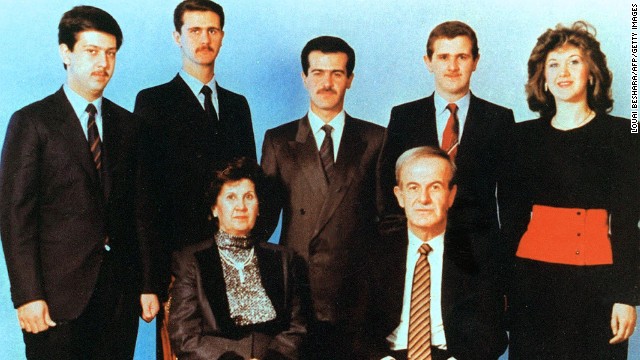 An undated photo shows current Syrian President Bashar al-Assad, second from left, posing with his family. Al-Assad's parents, then-President Hafez Assad and his wife, Anisa, in front, and his siblings in the second row; Maher, Bassel, Majd and Bushra.
An undated photo shows current Syrian President Bashar al-Assad, second from left, posing with his family. Al-Assad's parents, then-President Hafez Assad and his wife, Anisa, in front, and his siblings in the second row; Maher, Bassel, Majd and Bushra.  Al-Assad is seen in an 1997 photograph during the time his father, President Hafez Assad, reshuffled the top of the Syrian military. The move was seen as an effort to clear the way for al-Assad to rise to power.
Al-Assad is seen in an 1997 photograph during the time his father, President Hafez Assad, reshuffled the top of the Syrian military. The move was seen as an effort to clear the way for al-Assad to rise to power.  Al-Assad waves to supporters as he marches behind the coffin during his father's funeral in Damascus on June 13, 2000.
Al-Assad waves to supporters as he marches behind the coffin during his father's funeral in Damascus on June 13, 2000. 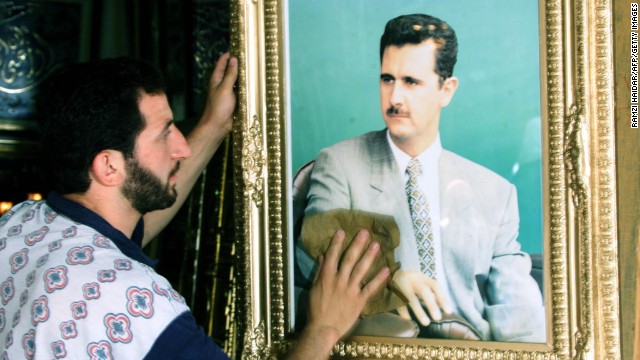 A shopkeeper cleans a portrait of al-Assad in Damascus on June 20, 2000, as the ruling Baath Party prepared to wind up its historic congress by consecrating al-Assad as its secretary-general and choosing a new leadership body.
A shopkeeper cleans a portrait of al-Assad in Damascus on June 20, 2000, as the ruling Baath Party prepared to wind up its historic congress by consecrating al-Assad as its secretary-general and choosing a new leadership body.  Syria's 250-member parliament approves by acclamation al-Assad's candidacy to succeed his late father as the country's president on June 27, 2000, in Damascus.
Syria's 250-member parliament approves by acclamation al-Assad's candidacy to succeed his late father as the country's president on June 27, 2000, in Damascus. 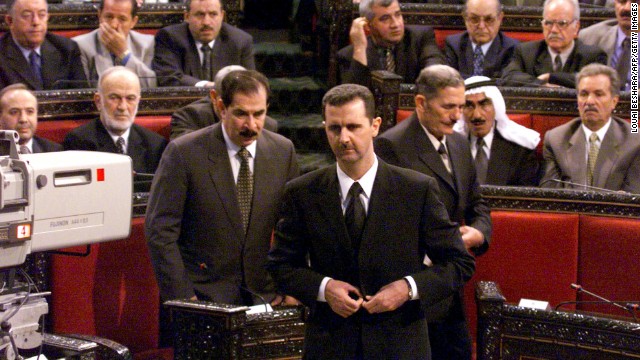 Al-Assad prepares to deliver a speech to parliament on July 17, 2000. It would be his first speech to parliament after taking the oath of office to become Syria's new president.
Al-Assad prepares to deliver a speech to parliament on July 17, 2000. It would be his first speech to parliament after taking the oath of office to become Syria's new president.  Jordanian King Abdullah ll and al-Assad inspect the honor guard on October 18, 2000, in Amman, Jordan.
Jordanian King Abdullah ll and al-Assad inspect the honor guard on October 18, 2000, in Amman, Jordan.  Al-Assad arrives at the airport in Sharm el-Sheikh, Egypt, on February 28, 2003.
Al-Assad arrives at the airport in Sharm el-Sheikh, Egypt, on February 28, 2003. 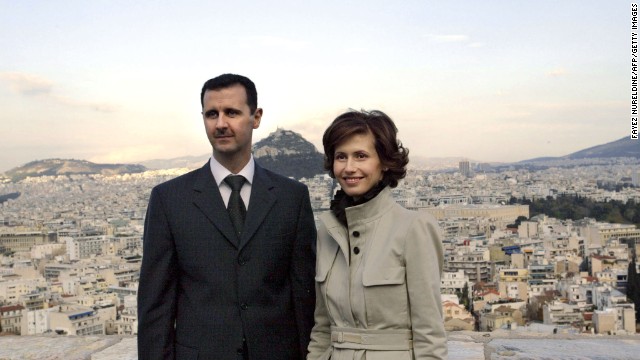 Al-Assad and his wife, Asma, pose during their visit to the Acropolis in downtown Athens on December 15, 2003.
Al-Assad and his wife, Asma, pose during their visit to the Acropolis in downtown Athens on December 15, 2003. 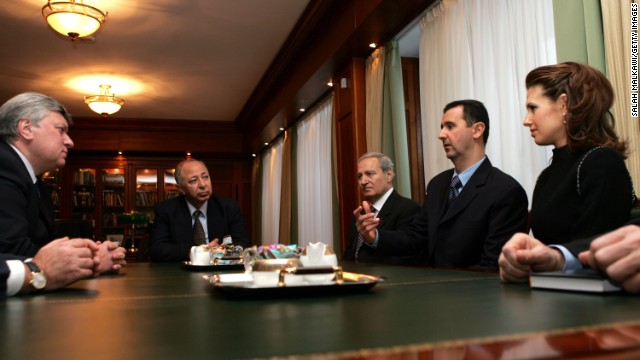 Al-Assad visits Moscow's State Institute for Foreign Relations in Moscow on January 25, 2005, where he was awarded with a honorary doctorate.
Al-Assad visits Moscow's State Institute for Foreign Relations in Moscow on January 25, 2005, where he was awarded with a honorary doctorate.  Asma al-Assad plants a jasmine bush with her husband in old Damascus on April 27, 2007.
Asma al-Assad plants a jasmine bush with her husband in old Damascus on April 27, 2007. 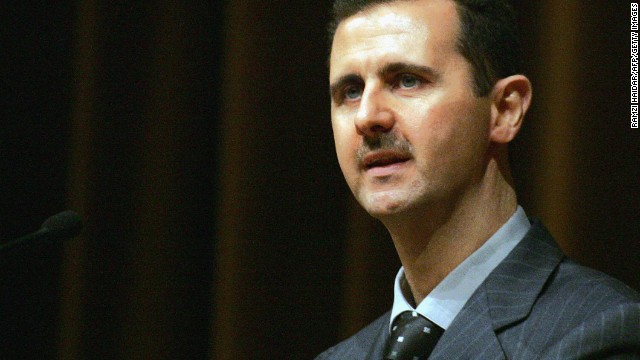 Al-Assad addresses the ruling Baath Party's 10th congress in Damascus on June 6, 2005.
Al-Assad addresses the ruling Baath Party's 10th congress in Damascus on June 6, 2005.  A Syrian woman walks past a large portrait of President al-Assad in downtown Damascus on December 13, 2005.
A Syrian woman walks past a large portrait of President al-Assad in downtown Damascus on December 13, 2005. 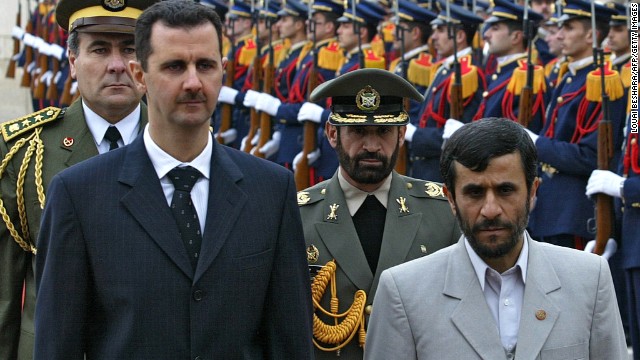 Al-Assad and Iran's Mahmoud Ahmadinejad review the honor guard at Damascus airport on January 19, 2006.
Al-Assad and Iran's Mahmoud Ahmadinejad review the honor guard at Damascus airport on January 19, 2006. 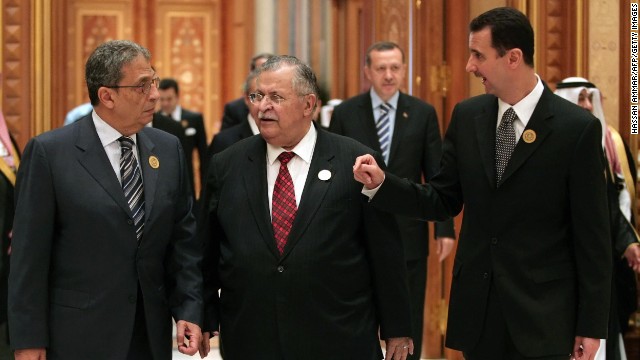 From left: Arab League Secretary-General Amr Moussa, Iraqi President Jalal Talabani and al-Assad talk at the Arab Summit in Riyadh, Saudi Arabia, on March 28, 2007.
From left: Arab League Secretary-General Amr Moussa, Iraqi President Jalal Talabani and al-Assad talk at the Arab Summit in Riyadh, Saudi Arabia, on March 28, 2007.  Two unidentified supporters of al-Assad join him on the balcony as he celebrates the referendum results in Damascus on May 29, 2007. Al-Assad won a second seven-year mandate after netting 97% of the vote in a referendum boycotted by the opposition.
Two unidentified supporters of al-Assad join him on the balcony as he celebrates the referendum results in Damascus on May 29, 2007. Al-Assad won a second seven-year mandate after netting 97% of the vote in a referendum boycotted by the opposition. 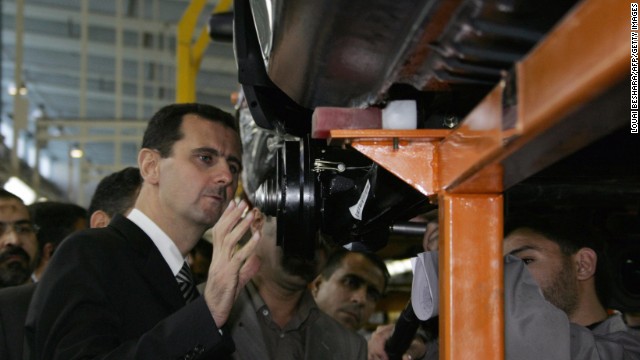 Al-Assad visits a Saba car production factory on December 13, 2007.
Al-Assad visits a Saba car production factory on December 13, 2007. 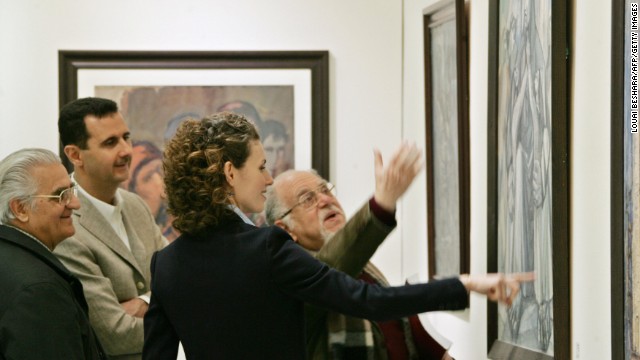 Bashar and Asma al-Assad listen to Syrian artist Elias al-Zayat during a visit to an exhibition at the national museum in Damascus on February 23, 2008.
Bashar and Asma al-Assad listen to Syrian artist Elias al-Zayat during a visit to an exhibition at the national museum in Damascus on February 23, 2008. 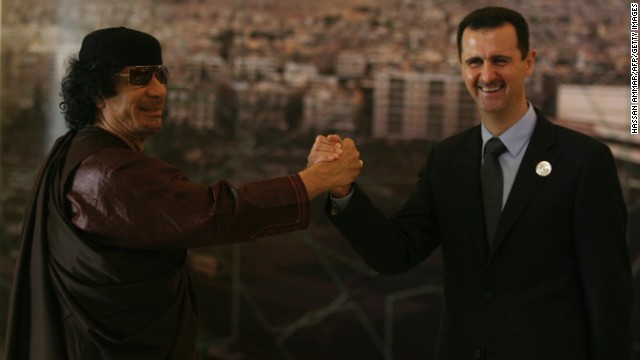 Moammar Gadhafi and al-Assad clasp hands at the opening session of the Arab Summit in Damascus on March 29, 2008.
Moammar Gadhafi and al-Assad clasp hands at the opening session of the Arab Summit in Damascus on March 29, 2008. 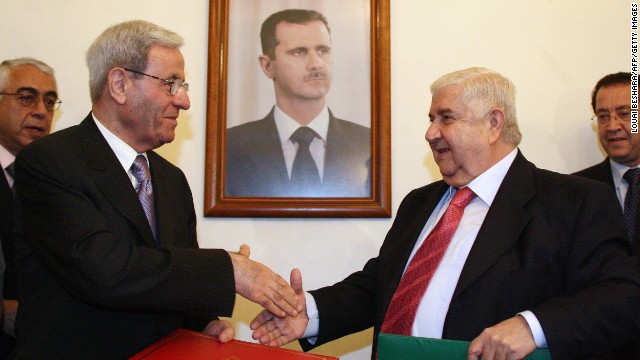 Syrian Foreign Minister Walid Muallem, right, and his Lebanese counterpart, Fawzi Salloukh, shake hands under a portrait of al-Assad in Damascus on October 15, 2008, after signing an agreement to restore diplomatic relations.
Syrian Foreign Minister Walid Muallem, right, and his Lebanese counterpart, Fawzi Salloukh, shake hands under a portrait of al-Assad in Damascus on October 15, 2008, after signing an agreement to restore diplomatic relations.  Asma al-Assad, left, appears with her husband and Austrian President Heinz Fischer and his wife, Margit, during a welcoming ceremonies on April 27, 2009, durring a two-day state visit to Vienna.
Asma al-Assad, left, appears with her husband and Austrian President Heinz Fischer and his wife, Margit, during a welcoming ceremonies on April 27, 2009, durring a two-day state visit to Vienna.  Al-Assad is seen at the Al-Shaab Palace in Damascus on June 24, 2009
Al-Assad is seen at the Al-Shaab Palace in Damascus on June 24, 2009 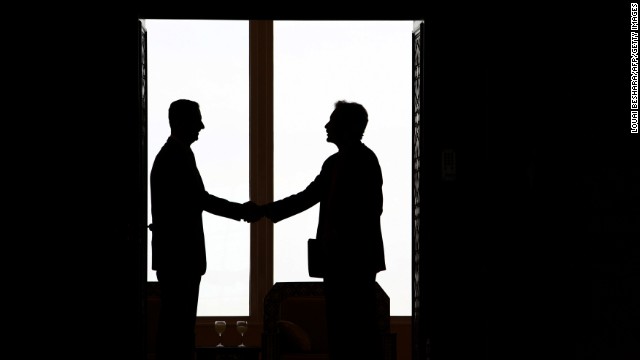 Al-Assad shakes hands with U.S. Under Secretary for Political Affairs William Burns in Damascus on February 17, 2010. Burns met the Syrian leader a day after Washington named its first ambassador to Damascus in five years.
Al-Assad shakes hands with U.S. Under Secretary for Political Affairs William Burns in Damascus on February 17, 2010. Burns met the Syrian leader a day after Washington named its first ambassador to Damascus in five years. 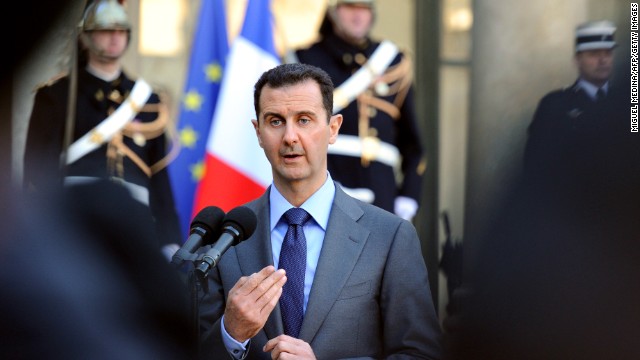 Al-Assad delivers a speech at Elysee Palace in Paris on December 9, 2010, after sharing a working lunch with his French counterpart, Nicolas Sarkozy, during a two-day official visit to France.
Al-Assad delivers a speech at Elysee Palace in Paris on December 9, 2010, after sharing a working lunch with his French counterpart, Nicolas Sarkozy, during a two-day official visit to France. 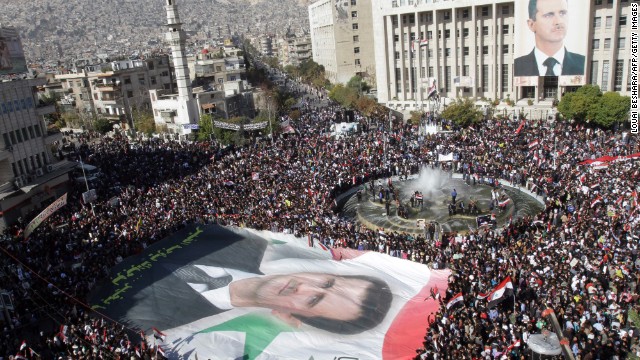 Syrian demonstrators carry a giant portrait of al-Assad in Damascus on November 28, 2011. Protesters waved Syrian flags and chanted nationalist songs in a demonstration against the Arab League's decision to impose crippling sanctions on the Assad regime.
Syrian demonstrators carry a giant portrait of al-Assad in Damascus on November 28, 2011. Protesters waved Syrian flags and chanted nationalist songs in a demonstration against the Arab League's decision to impose crippling sanctions on the Assad regime. 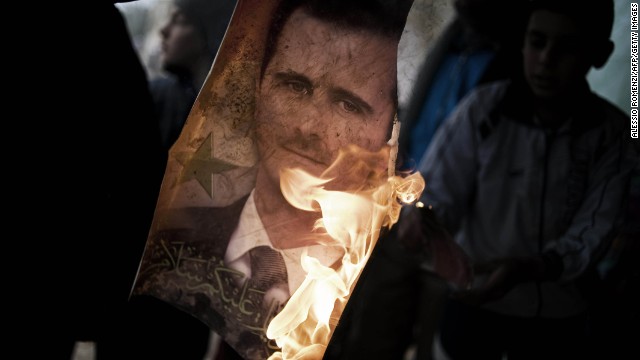 A member of the Free Syrian Army holds a burning portrait of al-Assad near the flashpoint city Homs on January 25, 2012.
A member of the Free Syrian Army holds a burning portrait of al-Assad near the flashpoint city Homs on January 25, 2012. 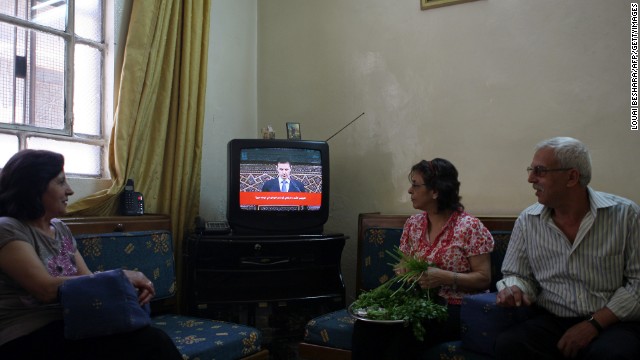 Syrians listen to a televised speech by al-Assad in Damascus on June 3, 2012. Al-Assad said that his government faces a foreign plot to destroy Syria and blamed "monsters" for the Houla massacre in a rare televised speech delivered in parliament.
Syrians listen to a televised speech by al-Assad in Damascus on June 3, 2012. Al-Assad said that his government faces a foreign plot to destroy Syria and blamed "monsters" for the Houla massacre in a rare televised speech delivered in parliament.  Al-Assad speaks with the Russian newspaper Izvestia in Damascus on August 26, 2013. He told the newspaper that Western accusations that the Syrian government used chemical weapons are an insult to common sense.
Al-Assad speaks with the Russian newspaper Izvestia in Damascus on August 26, 2013. He told the newspaper that Western accusations that the Syrian government used chemical weapons are an insult to common sense. 
1

2

3

4

5

6

7

8

9

10

11

12

13

14

15

16

17

18

19

20

21

22

23

24

25

26

27

28
- Aaron Miller says President Obama seems to be leaning to the least bad option in Syria
- He says limited strike may be risky but less so than doing nothing or trying for regime change
- Miller: If Obama doesn't act after large chemical weapons attack, he'll be written off as ineffective
Editor's note: Aaron David Miller is a vice president and distinguished scholar at the Woodrow Wilson International Center for Scholars and was a Middle East negotiator in Democratic and Republican administrations. Follow him on Twitter.
(CNN) -- Among the most enduring urban legends about high-level policy-making in the U.S. government is the proverbial memo with three options: 1. do nothing; 2. do everything; 3. find a middle ground and muddle through.
And yet in truth, Barack Obama really does have only three options in Syria. It appears that the president, rightly the avoider-in-chief when it comes to Syria, has chosen option three, the least bad alternative. And here's why.
Do nothing

This isn't really an option. Forget the fact that the president a year ago drew his own red line against Bashar al-Assad's use of chemical weapons. Disregard the reality that this is reportedly the largest single deployment of chemical weapons since Saddam Hussein used them against the Kurds in 1988; dismiss the fact that 100,000 Syrians have died in this civil conflict; and the president is accused of fiddling, Nero-like, while Syria burns.
Just focus on the events of the past five days in Washington. What has been emanating from administration officials both on and off the record is the most well-advertised and telegraphed military action in the history of modern warfare. Rarely do we get this kind of preview of the operation, its size and character.
Combine that with the Secretary of State John Kerry's brief but powerful statement of moral outrage the other day and the president's PBS interview, and you get as authoritative a commitment to strike as is humanly imaginable.
Indeed, forceful statements and actions of the past few days have now constituted their own red line. And if the president doesn't enforce it, he will be truly damaged goods when it comes to foreign policy for the remainder of his term.
Neither his regional allies (Israel and the Saudis) nor his adversaries (Iran, Hezbollah, Russia) will find him credible or believable. As it is now, everyone says no to the U.S. without much cost or consequence.
Do everything
From the beginning, Sens. John McCain and Lindsay Graham and a whole host of liberal interventionists and neoconservatives outside the government have repeatedly called for a more robust policy on Syria, even suggesting that the president, by not acting sooner, enabled all of this misery to unfold. Syria, the president's critics maintain, is a major threat to U.S. interests -- and to our allies in the region -- and only a takedown of the al-Assad regime through supporting the opposition and direct application of U.S. military power will begin to address the problem.
The argument has not called for boots on the ground but for extensive use of no-fly zones, the use of U.S. air and missile power to degrade the regime and military support for the opposition.
 Obama: Syria strikes would be limited
Obama: Syria strikes would be limited President Obama has wisely and willfully avoided this approach. And he continues to avoid it now. The reason has to do with the general problem of an open-ended military commitment and the lack of correlation between the use of U.S. military power and its relation to the end state.
Syria is in the throes of a brutal civil war. The opposition is composed of more than 1,000 disparate rebel groups, the most effective allied with al Qaeda and other Sunni extremists. A victory of the latter would be a blow to U.S. interests. Ousting al-Assad won't be cheap or easy. It took eight months to get rid of Libya's Moammar Gadhafi, and he had no weapons of mass destruction, no serious air defenses or military capacity and no credible allies. And look at the end result: a post-Gadhafi environment in which there are too many guns, grievances and regional rivalries and no credible central authority.
And Libya pales in comparison with Syria's complexities. Devising a serious military strategy to get rid of al-Assad -- serious weapons for the rebels; no-fly or -drive zones; and sustained air/missile strikes against Syrian military units, infrastructure and leadership targets -- also means U.S. responsibility for what follows. Barack Obama has avoided this option because he rightly doesn't want America getting stuck with the check for Syria.
Muddle through
The option the U.S. is likely to undertake -- focused more narrowly on trying to deter the Syrians from using chemical weapons again and degrading al-Assad's military capacity in the process -- is far from ideal. Although I think the administration's military actions will be far more devastating than the limited strikes being talked about, it is unlikely to change the arc of the battlefield balance.
There are other downsides, too. Once the glass ceiling against the use of force is broken, the expectations and pressures to use it again will grow. There's always the danger too of a response by Hezbollah or Syria against Israel, however unlikely. And sooner or later, al-Assad will commit some other horror that will require another U.S. response. This kind of episodic intervention without a real strategy can undermine American credibility, too.
To be sure, there are real risks in acting on option three, and Obama most assuredly is a reluctant warrior. Indeed, in view of the parliamentary opposition to British Prime Minister David Cameron's willingness to join the U.S., he may be a lonely warrior, too. But he's going to war with Syria nonetheless. Al-Assad's apparent use of chemical weapons, the president's own words and those of others in his administration leave him no other choice.
Follow @CNNOpinion on Twitter.
Join us at Facebook/CNNOpinion.
The opinions expressed in this commentary are solely those of Aaron Miller